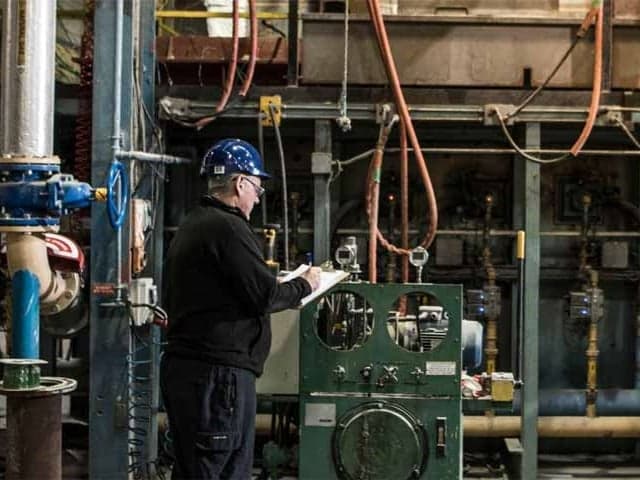Asbestos Testing Services
Element’s asbestos testing services offer flexible and scalable solutions to meet your needs. Whether for asbestos air testing, asbestos soil testing, or building materials, we ensure compliance, safety, and fast results. With on-site or lab testing tailored to unique site challenges, our end-to-end services identify asbestos risks and provide accurate, reliable results to protect your property and people.

What are Asbestos Testing Services at Element?
Asbestos testing involves identifying asbestos – for example, in materials, air, or soil - to ensure regulatory compliance and manage safety. Only licensed contractors can handle high-risk materials, and air testing & clearance certification are essential for confirming safe reoccupation after removal or remediation. Here at Element, we provide accurate asbestos air testing, asbestos soil testing, and material sampling services using UKAS-accredited labs and CoCA-certified experts. We test for all asbestos types, helping organizations and property managers assess and manage risk effectively in various environments.

What Can Element Offer You For Asbestos Testing Services?
Components and materials we test
Components and materials we test
Element's wide range of building materials and environmental samples including cement, vermiculite, insulation, floor tiles, ceiling tiles, air samples, and soil samples. We can identify and quantify all types of asbestos including chrysotile, amosite, crocidolite, tremolite, actinolite, and anthophyllite. We also test air samples for fiber levels before, during, or after asbestos-related activities.
Key tests offered
Key tests offered
- Bulk analysis testing
- Asbestos in soil testing (precise to 0.001%)
- Water absorption testing
- Asbestos air testing and 4-stage clearance certification – 4 main types:
- Background asbestos air testing
- For when you require evidence (or a check) that fiber levels in the air are below the recommended level.
- Personal asbestos air testing
- For evaluating asbestos exposure to your employees and is required in accordance with the Control of Asbestos Regulations 2012.
- Leak asbestos air testing
- To measure the airborne fiber concentration outside a live asbestos removal enclosure at your premises in order to determine whether the integrity of the enclosure is being maintained and that the control measures are adequate.
- Reassurance asbestos air testing
- To measure airborne fiber concentration following asbestos removal works to confirm that the residual asbestos fiber concentrations are <0.01 f/cm3.
Methods and solutions offered
Methods and solutions offered
We provide flexible testing solutions ensureing a comprehensive asbestos assessment, which is fully adaptable to your individual site needs:
- On-site and in-lab testing options.
- Sample collection by CoCA-qualified experts or self-submission.
- UKAS-accredited laboratories adhering to ISO/IEC 17025 and HSG248 standards.
- Tailored testing paths for unique challenges, ensuring precise results for every environment.
- Bulk analysis method to HSG248 guidelines confirms the presence or absence of asbestos in a given sample.
Cutting-edge equipment we use
Cutting-edge equipment we use
We use advanced analytical tools for fiber identification, quantification, and regulatory testing, ensuring precise results for air, soil, and materials.
Emergency response & support
Emergency response & support
Element offers rapid response capabilities for urgent testing needs through our network of local experts. We provide end-to-end service from a single provider.
Standards we test to and materials we test
- Air testing and clearance: HSG248 compliance for sampling, analysis, and clearance.
- Regulations: Control of Asbestos Regulations (CAR) 2012.
A range of materials, including chrysotile, amosite, crocidolite, tremolite, actinolite, and anthophyllite, covering a range of applications including but not limited to: air, soil, cement, vermiculite, insulation, floor tiles, pipe lagging, paints and ceiling tiles.
Your Challenges, Our Solutions
Health & Safety Risk Management
Emergency Asbestos Response Required
Complex Regulatory Compliance
Testing Logistics & Access
Element Experts at your service
Why Choose Element

In-lab and on-site testing
A faster, more cost-effective solution
Rapid Emergency Support
Meet Compliance and Quality Standards
0.001%precision
4stage clearance certification
14day notification
8,500+experts worldwide

Frequently asked questions
What is asbestos air testing?
Asbestos air testing measures fiber concentrations in the air to ensure safe levels before, during, or after activities like removal or demolition.
How accurate is asbestos soil testing at Element?
Element’s asbestos soil testing quantifies asbestos fibers with precision to 0.001%, ensuring detailed analysis for contamination risks.
Can Element handle urgent testing requests?
Yes, Element offers emergency response services with local experts providing on-site or lab testing for immediate results.
What is included in a 4-stage clearance certification?
The certification includes air testing and inspection to confirm that an area is safe for reoccupation following asbestos removal.

Explore our global network of labs and find your nearest location
VIEW ALL LOCATIONSRelated services

Asbestos Services
Element offers expert asbestos services: rapid testing, surveys, advisory services and compliance. Our UKAS-accredited labs help you reach 0.001% precision and offer emergency response.

Asbestos Advisory Services
Element offers UKAS accredited asbestos advisory services and training for a wide range of commercial, industrial, and domestic organizations.

Hazardous Materials Testing and Inspection
Element helps you to protect your employees by conducting hazardous materials testing & inspection to manage and safely dispose of any hazardous waste.


